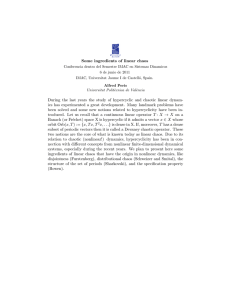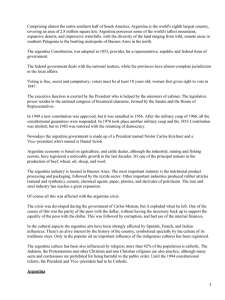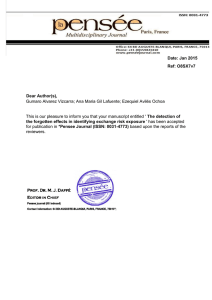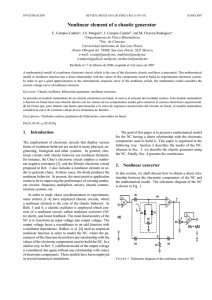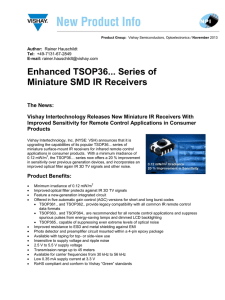A Novel MLSD Receiver Architecture for Nonlinear Channels
Anuncio
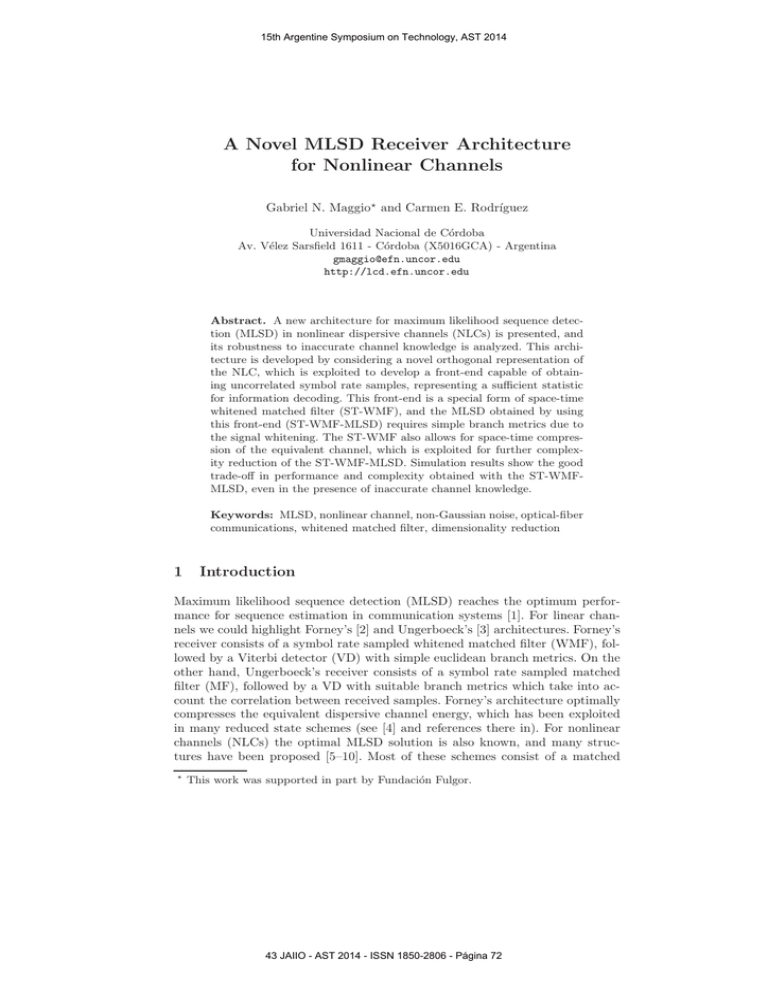
15th Argentine Symposium on Technology, AST 2014 A Novel MLSD Receiver Architecture for Nonlinear Channels Gabriel N. Maggio⋆ and Carmen E. Rodrı́guez Universidad Nacional de Córdoba Av. Vélez Sarsfield 1611 - Córdoba (X5016GCA) - Argentina [email protected] http://lcd.efn.uncor.edu Abstract. A new architecture for maximum likelihood sequence detection (MLSD) in nonlinear dispersive channels (NLCs) is presented, and its robustness to inaccurate channel knowledge is analyzed. This architecture is developed by considering a novel orthogonal representation of the NLC, which is exploited to develop a front-end capable of obtaining uncorrelated symbol rate samples, representing a sufficient statistic for information decoding. This front-end is a special form of space-time whitened matched filter (ST-WMF), and the MLSD obtained by using this front-end (ST-WMF-MLSD) requires simple branch metrics due to the signal whitening. The ST-WMF also allows for space-time compression of the equivalent channel, which is exploited for further complexity reduction of the ST-WMF-MLSD. Simulation results show the good trade-off in performance and complexity obtained with the ST-WMFMLSD, even in the presence of inaccurate channel knowledge. Keywords: MLSD, nonlinear channel, non-Gaussian noise, optical-fiber communications, whitened matched filter, dimensionality reduction 1 Introduction Maximum likelihood sequence detection (MLSD) reaches the optimum performance for sequence estimation in communication systems [1]. For linear channels we could highlight Forney’s [2] and Ungerboeck’s [3] architectures. Forney’s receiver consists of a symbol rate sampled whitened matched filter (WMF), followed by a Viterbi detector (VD) with simple euclidean branch metrics. On the other hand, Ungerboeck’s receiver consists of a symbol rate sampled matched filter (MF), followed by a VD with suitable branch metrics which take into account the correlation between received samples. Forney’s architecture optimally compresses the equivalent dispersive channel energy, which has been exploited in many reduced state schemes (see [4] and references there in). For nonlinear channels (NLCs) the optimal MLSD solution is also known, and many structures have been proposed [5–10]. Most of these schemes consist of a matched ⋆ This work was supported in part by Fundación Fulgor. 43 JAIIO - AST 2014 - ISSN 1850-2806 - Página 72 15th Argentine Symposium on Technology, AST 2014 filter bank (MFB) sampled at the symbol rate, and followed by a VD with suitable branch metrics to take into account the nonlinear intersymbol interference (ISI) and noise correlation. The receiver in [9] consists of a wide-band filter with oversampling to obtain uncorrelated samples representing a sufficient statistic. The structures in [7, 10] use special front-ends to obtain uncorrelated symbol rate samples. Despite their optimum performance, MLSD receivers may have a prohibitive complexity in highly dispersive NLCs, and suboptimum equalizers may be preferred in many practical applications. Long haul optical intensity modulated (IM) transmissions with direct detection (DD) are extremely low cost communication systems, that have the drawback of being one of the scenarios where the strong nonlinear ISI imposes the use of MLSD receivers to make communication possible. While suboptimum equalizers fail to compensate the nonlinear distortion in channels with a few tens of kilometers, it was observed that the IM/DD link can be compensated with a ∼ 3dB loss respect to back-to-back in links up to 1000km [11]. However, the complexity required by known MLSD receivers limits the practical transmission distance to just a few hundreds of kilometers. Thus, reduced complexity MLSD receivers are required in practical applications such as IM/DD optical links, even with actual integration capabilities. Oversampled MLSD (OS-MLSD) receivers, developed upon the philosophy in [9], are widely used for theoretical and experimental investigations in IM/DD fiber optic transmissions [11, 12]. In this article we present further results obtained with the novel ST-WMF-MLSD receiver presented in [10]. In [10] it is shown how the ST-WMF-MLSD structure presents a smooth degradation of performance when complexity is reduced. The results presented in this article extend those in [10], showing that the ST-WMF-MLSD achieves a good performance even in the presence of imperfect channel knowledge. This article is structured as follows. Section 2 describes the NLC model, and Section 3 describes the ST-WMF-MLSD architecture. Numerical results are presented in Section 4, while final conclusions are drawn in Section 5. 2 Nonlinear Channel Model The noisy received signal is given by r(t) =s(t) + z(t), (1) where s(t) is the noise-free signal and z(t) is the noise component, which is assumed to be a white Gaussian process with power spectral density N0 . Component s(t) can be expressed by using its Volterra-series expansion. For example, 43 JAIIO - AST 2014 - ISSN 1850-2806 - Página 73 15th Argentine Symposium on Technology, AST 2014 in optical IM/DD systems we get12 s(t) = X ak f0 (t − kT ) + N −1 X X ak ak−m fm (t − kT ), (2) m=1 k k where f0 (t) is the linear kernel, fm (t), with m > 0, is the m-th second-order kernel [13], ak is the k-th symbol at the input of the nonlinear channel, 1/T is the symbol rate, and N is the total number of kernels. 2.1 Channel Model Orthogonalization Next we present an alternative representation of the nonlinear signal s(t) [10]. Without loss of generality, we consider here the Volterra-series with a dominant linear kernel f0 (t), and we select the first pivoting response as h0 (t) = f0 (t). Let H0 be the signal space spanned by the set {h0 (t − kT )} [1]. We R ∞ assume that signal spaces are Hilbert spaces with inner product defined as −∞ x(t)y ∗ (t)dt, where superscript ∗ denotes complex conjugate. From the projection theorem, the nonlinear kernels fm (t) can be uniquely expressed as X (0) (t), (3) h0 (t − nT ) + gm fm (t) = λ(0,m) n n (0) where gm (t) is orthogonal to the signal space H0 , i.e., Z ∞ (0) gm (t)h∗0 (t − jT )dt = 0, m = 1, ..., N − 1, ∀j ∈ Z, (4) −∞ R ∞ (0) while −∞ |gm (t)|2 dt is minimum [1], and Z denotes the set of all integers. We highlight that the first summation in eq. (3) is the projection of fm (t) onto H0 . (0) 0 Define Gm as the signal space Rspanned by {gm (t − kT )}. For x(t) ∈ H0 and ∞ 0 y(t) ∈ Gm , from (4) note that −∞ x(t)y ∗ (t)dt = 0, therefore x(t) and y(t) are orthogonal signals [1]. Replacing (3) in (2) and operating, we can obtain s(t) = s0 (t) + s0 (t), (5) where s0 (t) = X k s0 (t) = " ak + −1 X NX N −1 X ak ak−m ⊗ (0,m) λk m=1 # h0 (t − kT ), (0) ak ak−m gm (t − kT ), (6a) (6b) k m=1 1 2 The DC term of the series expansion is omitted. Note that (2) only considers kernels up to second-order. This is just to keep the notation as simple as possible, however the ST-WMF-MLSD is not limited in the order of nonlinearity it can handle. 43 JAIIO - AST 2014 - ISSN 1850-2806 - Página 74 15th Argentine Symposium on Technology, AST 2014 with operator ⊗ denoting convolution. Notice that s0 (t) ∈ H0 and s0 (t) ∈ −1 0 ∪N m=1 Gm , therefore signals s0 (t) and s0 (t) are orthogonal (see (4) and associated discussion). Without loss of generality, we select the second pivoting response as (0) h1 (t) = g1 (t), then eq. (6b) can be rewritten as " # N −1 X X (0) s0 (t) = ak ak−1 h1 (t − kT ) + ak−m gm (t − kT ) . (7) m=2 k Similarly to (5)-(6), s0 (t) can be expressed as s0 (t) = s1 (t) + s1 (t), where " # N −1 X X (1,m) s1 (t) = ak ak−1 + ak ak−m ⊗ λk h1 (t − kT ), (8a) m=2 k s1 (t) = −1 X NX (1) ak ak−m gm (t − kT ), (8b) k m=2 (1,m) with λn chosen to satisfy Z ∞ (1) gm (t)h∗1 (t − jT )dt = 0, for m = 2, ..., N − 1, ∀j ∈ Z. (9) −∞ Thus, note that s1 (t) is orthogonal to the signal spaces H0 and H1 , spanned by {h0 (t − kT )} and {h1 (t − kT )}, respectively. Repeating the processing on eqs. (4)-(6) and (7)-(9), and generalizing, we can get s(t) = N −1 X n=0 sn (t) = N −1 X X n=0 (n) bk hn (t − kT ), (n) where hn (t) is the response of the n-th channel path, and bk (n) bk with (10) k is given by PN −1 (0,m) if n = 0 ak + m=1 ak ak−m ⊗ λk PN −1 = ak ak−n + m=n+1 ak ak−m ⊗ λ(n,m) if 0 < n < N − 1 k a a if n = N − 1, k k−N +1 Z (11) ∞ hm (t)h∗n (t − jT )dt = 0 m 6= n, ∀j ∈ Z. (12) ∀ j ∈ Z with m 6= n. (13) −∞ From (10) and (12) note that Z ∞ sm (t)s∗n (t − jT )dt = 0, −∞ Equation (13) is a sort of extended orthogonality condition3 , that will be an important property for the development of the ST-WMF-MLSD in Section 3. 3 The classical orthogonality condition corresponds to the particular case of (13) with j = 0. 43 JAIIO - AST 2014 - ISSN 1850-2806 - Página 75 15th Argentine Symposium on Technology, AST 2014 Note that at the i-th orthogonalization step, the energy of the signal component orthogonal to the subspace ∪i−1 l=0 Hl is minimized (see (3)-(4)). Then, a proper selection of the pivoting response at each step will maximize the signal energy in the first paths. 3 ST-WMF-MLSD for Nonlinear Channels The MLSD receiver chooses the sequence {ak } that minimizes the metric Z ∞ |r(t) − s(t)|2 dt. (14) J= −∞ Using (9) and (10) in (14), it can be shown that all the information in the received signal r(t), needed to estimate the information sequence {ak }, is contained in (0) (1) (N −1) T the sequence vector r̄k = [r̄k , r̄k , . . . , r̄k ] , where (n) r̄k = r(t) ⊗ h∗n (−t)|t=kT , n = 0, 1, . . . , N − 1 (15) are the symbol rate sampled outputs of a bank of filters matched to the path −1 responses {hn (t)}N n=0 , as shown in Fig. 1 (see the first block denoted as S-WMF). (n) (n) (n) Let r̄k = s̄k + z̄k be the decomposition of the n-th MF sampled output (n) (m)∗ into its signal and noise components. It follows from (13) that E[z̄l z̄l−k ] = R ∞ (n) (n) N0 ρk δn−m , with ρk = −∞ hn (t)h∗n (t − kT )dt, and δi denotes the Kronecker’s delta. Then, the MFB in (15) produces a vector process r̄k with spatially uncorrelated components (independent because of the Gaussian assumption). We call this filter bank and symbol rate sampler as the space-whitening MF (S-WMF), as shown in the first block of Fig. 1. Note the S-WMF in Fig. 1 is implemented with P filters instead of N . The parameter choice P < N can be used to reduce complexity by spatial truncation, which introduces negligible degradation as discussed in Section 2.1, and we shall verify it in Section 4 by numerical simulations in IM/DD optical transmissions. Let Sn (z) = Mn (z)Mn∗ (1/z ∗) be the folded spectral factorization of Sn (z), (n) with Sn (z) and Mn (z) being the Z-transforms of the sequence ρk and the (n) minimum-phase response mk , respectively (see eq. (5.80) in [1] for more details). Then, it is straightforward to show that by filtering r̄k with a bank of −1 scalar whitening filters (WF) {Mn−∗ (1/z ∗ )}N n=0 , results in the process iT h (N −1) (0) (1) , (16) r̃k = r̃k r̃k . . . r̃k that besides being spatially independent is also time independent. Let w be the vector with the noise components of r̃k , then its power spectral density results SW = N0 I, where I is the identity matrix. Then, the MLSD results in the minimization of the simple euclidean metric J = kr̃k − s̃k k2 , where s̃k is the signal component of r̃k , and is given by h iT (0) (1) (N −1) s̃k = s̃k s̃k . . . s̃k = M k ⊗ bk , (17) 43 JAIIO - AST 2014 - ISSN 1850-2806 - Página 76 15th Argentine Symposium on Technology, AST 2014 Fig. 1. Block diagram of the P -dimensional ST-WMF-MLSD receiver. while Mk represents the N × N diagonal matrix h i (0) (1) (N −1) diag{Mk } = mk mk . . . mk , and h iT (0) (1) (N −1) {bk } = bk bk . . . bk . (18) (19) Figure 1 shows the implementation of the time-whitening filter (T-WF) Mk . The concatenation of the S-WMF and the T-WF results in the ST-WMF, also indicated in Fig 1. The MLSD based on the ST-WMF (ST-WMF-MLSD) then 2 minimizes J = kr̃k − s̃k k , with a traditional VD with simple P -dimensional branch metrics. Note that P < N , as suggested in Fig. 1, can be used to reduce complexity thanks to the energy compression obtained with the novel orthogonal representation proposed in Section 2.1. As the scalar components of the response Mk are minimum-phase, its energy is compressed in time [1]. These properties can be exploited to reduce the number of states in the VD and the complexity of the branch metrics. 4 ST-WMF-MLSD in IM/DD Optical Systems Next we analyze the proposed ST-WMF-MLSD receiver in transmissions over IM/DD fiber-optic systems with on-off keying (OOK) modulation. We focus on two key aspects of ST-WMF-MLSD: its performance (in comparison with current solutions based on OS-MLSD), and its ability to reduce complexity (e.g., number of states of VD). Complexity reduction is possible owing to (i) the minimumphase property of the equivalent channel response provided by ST-WMF, and (ii) the spatial compression property. The latter gives rise to reduction of the ST-WMF dimension, P . This is achieved by using the most significant P paths of the nonlinear channel in (10). Figure 2 depicts the optical system under consideration. The transmitter modulates the intensity of the transmitted signal using NRZ OOK modulation. Data rate is 1/T = 10Gb/s, and the transmitted pulse has an unchirped Gaus2 2 sian envelope e−t /2T0 with T0 = 36ps. The standard single mode fiber (SMF) 43 JAIIO - AST 2014 - ISSN 1850-2806 - Página 77 15th Argentine Symposium on Technology, AST 2014 Fig. 2. IM/DD fiber-optic system with ST-WMF-MLSD receiver. introduces CD (17 ps/(nm-km)), as well as attenuation. Optical amplifiers deployed along the fiber introduce amplified spontaneous emission (ASE) noise in the signal, which is modeled as AWGN in the optical domain. The received optical signal is filtered by a Lorentzian optical filter (15GHz), and then converted to a current with a PIN diode or avalanche photodetector. The resulting photocurrent is filtered by a fourth-pole Butterworth electrical filter (10GHz). The noise component after the electrical filtering is non-Gaussian and signaldependent [14]. Therefore, the electrical signal is first processed by a memoryless nonlinear transformation. It has been found that after a square root transformation, the noise can be assumed Gaussian and signal-independent [12, 15]. Furthermore, channel nonlinearities can also be reduced by using the square root transformation [16], which also improves the space compression used to reduce the receiver dimension (i.e., most of the channel energy is concentrated on the linear kernel). The split-step Fourier method is used to compute the propagation of optical signals through the fiber. Oversampled linear and nonlinear kernels are extracted from the electrical signal after the square root transformation. The oversampling factor is T /Ts = 16. Then, we compute hn (kTs ) and (n,m) λk according to (6a) and (8a), and the symbol rate channel response matrix Mk can be easily obtained from (18). Since the noise after the square root transformation is approximately Gaussian and signal-independent [15], the theory proposed in [17] is used to evaluate the bit error probability. All the kernels of the nonlinear channel are used to compute the error probability, independently of the receiver dimension, P . 4.1 Performance with Perfect Channel Knowledge Figure 3-A shows the penalty of the optical signal-to-noise ratio (OSNR) at BER= 10−3 , as a function of the fiber length, L. We present results for two unconstrained complexity receivers (i.e., without reduction of the number of states of the VD): ST-WMF-MLSD with P = 2, and OS-MLSD with 2 samples/bit (note that the branch metric dimensions of both VDs are the same). From Fig. 3-A we observe that both receivers have essentially the same performance, with a negligible loss with ST-WMF-MLSD, caused by using P < N . Figure 3-B depicts the OSNR penalty at BER= 10−3 versus the number of states of the VD for L = 700 km. We also present results for ST-WMF-MLSD with P = 1 (i.e., only one filter in the bank). For OS-MLSD with 2 samples/bit, 43 JAIIO - AST 2014 - ISSN 1850-2806 - Página 78 15th Argentine Symposium on Technology, AST 2014 (A) (B) 4.5 8 ∆ OSNR @ BER=10 −3 [dB] 4 OSNR Penalty @ BER=10−3 [dB] ST−WMF−MLSD (P=2 filters) OS−MLSD (2 samples/bit) 3.5 3 2.5 2 1.5 1 0.5 0 0 200 400 ST−WMF−MLSD (P=1 filter) OS−MLSD (2 samples/bit) MLSD Bound 7.5 7 6.5 6 5.5 5 4.5 4 3.5 3 600 Fiber Length [km] 6 8 10 12 14 16 18 log2(Number of States) Fig. 3. (A): OSNR penalty at BER = 10−3 versus fiber length with unconstrained complexity receivers. (B): OSNR penalty at BER = 10−3 versus number of states of the VD with L = 700 km. where the reduction of states is achieved by truncation and optimization of the sampling phase in order to minimize BER (8 uniformly distributed phases in the interval T /2 were tested). From Fig. 3-B, we verify that the number of states of the VD at a penalty of 4.6 dB can be reduced from 2048 to 256 with ST-WMFMLSD and P = 1. Notice that this performance is achieved by using a VD with one sample per bit. Furthermore, we emphasize that these benefits widely outperform the extra complexity required by the linear filter and the channel estimator. 4.2 Performance with Imperfect Channel Knowledge The performance evaluation of the proposed ST-WMF-MLSD architecture in −1 Fig. 3 has been achieved assuming a perfect knowledge of the channel ({fn (t)}N n=0 ). Then we present a simple analysis about the impact of the channel estimation inaccuracy on the performance of the ST-WMF-MLSD architecture in transmissions over IM/DD optical systems. This study shows that the performance degradation in ST-WMF-MLSD receivers caused by an imperfect channel estimation is low (∼ 0.2) dB, and similar to that achieved by oversampled OS-MLSD receivers in the L = 700 km fiber link used in the example of Fig. 3-B. The estimation of the oversampled linear and nonlinear kernels is required to implement both MLSD-based receivers. Let R = T /Ts be the oversampling factor. Based on the polyphase filter representation of the oversampled channel response, the received samples can be expressed as rn(i) = X k (i) ak f0 [n − k] + −1 X NX (i) ak ak−m fm [n − k] + zn(i) , k m=1 43 JAIIO - AST 2014 - ISSN 1850-2806 - Página 79 (20) 15th Argentine Symposium on Technology, AST 2014 (i) (i) (i) where rn = r(nT + iTs ), zn = z(nT + iTs ), and fm [n] = fm (nT + iTs ) with (i) i = 0, ..., R − 1. Notice that there are R different symbol rate sequences rn . Since symbols ak are assumed zero-mean and i.i.d. real random variables with σa2 = E |ak |2 , we can verify that 1 E{rn(i) an−k }, σa2 1 (i) fm [k] = 4 E{rn(i) an−k an−k−m }, σa (i) f0 [k] = i = 0, ..., R − 1. (21) From (21), a simple estimator of the oversampled linear and nonlinear kernels can be implemented with an averaging filter as follows4 : (i) fˆ0 [k] = 1 2 σa LA 1 (i) fˆm [k] = 4 σa LA n0 +L XA −1 rn(i) ân−k , n=n0 n0 +L XA −1 (22) rn(i) ân−k ân−k−m , n=n0 where LA is the length of the averaging filter, n0 is an arbitrary time index, and âk is the detected symbol. The accuracy of the channel estimation given by (22) depends on the precision of the decisions âk , the length of the averaging filter LA , and the channel noise power. We consider that decisions provided by the forward error correction (FEC) decoder are available, therefore the effect of decision errors can be neglected (i.e., âk = ak ). We highlight that this assumption is still valid if pre-FEC decisions are used as a result of the low bit error rates experienced in this link (e.g., ∼ 10−3 ). From the above, we conclude that the goodness of the estimates (22) shall mainly depend on the filter length LA and the channel noise power. The precision of (22) improves as the value of LA increases. On the other hand, the maximum value of LA shall be imposed by the speed of temporal variations of the fiber optic channel. As a result of its dependence on stress and vibrations, as well as on random changes in the state of polarization of the laser, PMD is nonstationary. Fluctuations with a time scale of a hundreds of microseconds have been considered in previous works (e.g., [18]). Therefore, the response time of channel estimation algorithms for PMD mitigation must be less than 1 ms (in practice a response time less than 100 µs is required [15]). This imposes, e.g., that the bandwidth of the averaging filter (∼ 1/(4LA T )) should be & 20 KHz in order to efficiently track the channel variation. 4 In order to improve the channel tracking capability, an efficient implementation of the channel estimator with the well-known LMS algorithm may be preferred. Nevertheless, the objective is to shed light on the impact of imperfect knowledge of the fiber dispersion on the orthogonalized Volterra model. Therefore, practical aspects of the receiver architecture (e.g., buffers, number of taps of the WF, finite precision arithmetic effects, etc.) are not considered. 43 JAIIO - AST 2014 - ISSN 1850-2806 - Página 80 15th Argentine Symposium on Technology, AST 2014 (B) 2.2 2 2 SNR Penalty, ∆ SNR [dB] SNR Penalty, ∆ SNR [dB] (A) 2.2 1.8 1.6 1.4 1.2 1 0.8 0.6 0.4 0.2 0 1.8 1.6 1.4 1.2 1 0.8 0.6 0.4 0.5 1 1.5 Filter Length, L A 2 5 x 10 0.2 4 10 5 10 6 10 Averaging Filter BW [Hz] Fig. 4. (A) Penalty of SNR caused by imperfect channel estimation versus length of the averaging filter, and (B) the bandwidth of the averaging filter. The received signal seen by an OS-MLSD receiver in the presence of imperfect knowledge of the channel dispersion can be expressed as ! N −1 X X (i) (i) (i) (i) r̃n(i) = an−k f0 [k] + an−k−m fm [k] +zn(i) +ẑn(i) = s(i) n +zn +ẑn (23) k (i) m=1 (i) where sn = s(nT + iTs ), ẑn = ŝ(nT + iTs ) − s(nT + iTs ) is the estimation error component, while ŝ(nT + iTs ) is the synthesized signal obtained from (22). Figure 4-A shows a first approximation of the SNR penalty caused by the imperfect channel estimation as a function of LA , obtained from computer simulations. We consider 1/T = 10 GHz, R = 16, and the fiber link with L = 700 km, as used in Fig. 3-B. The approximate SNR penalty caused by an imperfect channel estimation is then computed as ∆SN R = σz2 + σẑ2 , σz2 (24) where σz2 is the channel noise power required to achieve a BER = 10−3 with an unconstrained complexity OS-MLSD receiver, and σẑ2 is the variance of the estimation error component5 . Notice that the penalty is ∼ 0.4 dB for LA = 105 . This value of LA represents a BW of ∼ 1/(4LA T ) = 25 KHz (see Fig. 4-B). Assuming that the estimation error is white Gaussian noise, with power σẑ2 , from Fig. 4-A we infer that the SNR penalty caused by an imperfect channel knowledge in OS-MLSD receivers with LA = 105 should be . ∆SN R ∼ 0.4 dB. On the other hand, Fig. 5 depicts the SNR penalty at BER = 10−3 versus the number of states of the VD with L = 700 km. In this case the performance is estimated considering the missmatched ST-WMF and VD receivers, which are 5 The mean penalty of 20 runs with different seeds of the random number generator is presented. 43 JAIIO - AST 2014 - ISSN 1850-2806 - Página 81 15th Argentine Symposium on Technology, AST 2014 OSNR Penalty @ BER=10 −3 [dB] 8 ST−WMF−MLSD (P=1 filter) − LA=∞ 7.5 5 ST−WMF−MLSD (P=1 filter) − LA=10 OS−MLSD (2 samples/bit) − LA=∞ 7 OS−MLSD (2 samples/bit) − LA=105 6.5 MLSD Bound − LA=∞ 6 5.5 5 4.5 4 3.5 3 6 8 10 12 14 16 18 log2(Number of States) Fig. 5. OSNR penalty at BER = 10−3 versus number of states of the VD for L = 700 km. −1 N −1 designed according to {fˆn (t)}N n=0 , instead of {fn (t)}n=0 . The error probability is computed as described in [17]. We present results with perfect knowledge of the fiber dispersion (denoted as LA = ∞), and for imperfect channel estimation with LA = 105 . We see that the mean penalty caused by inaccuracies of channel estimation agrees with that expected from Fig. 4 with LA = 105 (i.e., ∼ 0.14 dB < ∆SN R ∼ 0.4 dB). Furthermore, we observe that the impact of imperfect channel knowledge on the performance is similar in both MLSD receivers (i.e., ∼ 0.14 dB and 0.18 dB for OS and ST-WMF, respectively). This result can be (0) understood from the fact that the filters h∗0 (−t) and mk are computed from the samples of the estimated linear kernel fˆ0 (t). Taking into account that the energy of the linear component is significantly higher than the nonlinear kernels [16] due to the spatial compression property, an accurate estimation of h0 (t) can be achieved for the channel considered. Then, we infer that the energy loss of the signal component at the output of m̂0 (t) will be small. Therefore, and based on eq. (23), notice that the performance of OS-MLSD and ST-WMF-MLSD with P = 1 should degrade in a similar way. 5 Conclusions We have introduced and analyzed a novel MLSD structure for nonlinear dispersive channels, the ST-WMF-MLSD. A procedure to maximize the spatial compression of ST-WMF-MLSD has been also proposed, and its benefits have been demonstrated by computer simulations. Performance degradation caused by imperfect channel knowledge has been analyzed. Simulation results have shown the excellent robustness of ST-WMF-MLSD to imperfect channel knowledge. These results make the ST-WMF-MLSD an architecture to be considered for high speed and high performance applications over dispersive NLCs. 43 JAIIO - AST 2014 - ISSN 1850-2806 - Página 82 15th Argentine Symposium on Technology, AST 2014 References 1. J R. Barry, E.A. Lee, D.G. Messerschmitt: Digital Communications, New Yory, NY, USA: Springer-Verlag, 2004. 2. G. D. Forney, Jr.: Maximum Likelihood Sequence Detection in the Presence of Intersymbol Interference, IEEE J. Inf. Theory, vol. 18, pp. 363-378, May 1972. 3. G. Ungerboeck: Adaptive Maximum-Likelihood Receiver for Carrier-Modulated Data-Transmission Systems, IEEE J. Comm., vol. 22, no. 5, pp. 624-636, May, 1974. 4. M. V. Eyuboglu, S. U. H. Qureshi: Reduced-State Sequence Estimation with Set Partitioning and Decision Feedback, IEEE Trans. Commun. ,vol. 36, pp.13-20, Jan, 1988. 5. M. F. Mesiya, P.J. Mc Lane, L.L. Campbell: Maximum Likelihood Sequence Estimation of Binary Sequences Transmitted Over Bandlimited Nonlinear Channels, IEEE J. Comm., vol. 25, no. 7, pp. 633-643, Jul, 1977. 6. V. K. Dubey, D. Taylor: Maximum Likelihood Sequence Detection for QPSK on Nonlinear, Band-Limited Channels, IEEE J. Comm., vol. 34, no. 12, pp. 1225-1235, Dec, 1986. 7. T. E. Stern: Viterbi Algorithm Receivers For Nonlinear Satellite Channels, in Proc. 11th Asilomar Conference on Circuits, Systems and Computers. Conference Record., pp. 219-224, Nov, 1977. 8. S. Benedetto, E. Biglieri: Principles of Digital Transmission with Wireless Applications, Norwell, MA, USA: Kluwer Academic (1999). 9. A. Vannucci, R. Raheli: Sequence Detection in Nonlinear Channels: A Convenient Alternative to Analog Predistortion, IEEE J. Comm., vol. 50, no. 9, pp. 1515-1524, Sep, 2002. 10. G.N. Maggio, M.R. Hueda, O.E. Agazzi: Reduced Complexity MLSD Receivers for Nonlinear Optical Channels, IEEE Photon. Technol. Lett., vol. 26, no. 4, pp. 398-401, Feb 15, 2014. 11. S. Savory, et. al.: IMDD Transmission over 1,040 km of Standard Single-Mode Fiber at 10Gbit/s using a One-Sample-per-Bit Reduced-Complexity MLSE Receiver, in Proc. OFC, pp. 1-3, Mar, 2007. 12. G. Bosco, P. Poggiolini: Long-Distance Effectiveness of MLSE IMDD Receivers, IEEE Photon. Technol. Lett., vol. 18, no. 9, pp. 1037-1039, May 1, 2006. 13. W. Chung: Channel Estimation Methods Based on Volterra Kernels for MLSD in Optical Communication Systems, IEEE Photon. Technol. Lett., vol. 22, no.4, pp. 224-226, Feb 2010. 14. O. E. Agazzi, et. al.: Maximum-Likelihood Sequence Estimation in Dispersive Optical Channels, IEEE J. Lightw. Technol., vol. 23, no. 2, pp. 749-763, Feb, 2005. 15. M. R. Hueda, et. al.: Parametric Estimation of IM/DD Optical Channels Using New Closed-Form Approximations of the Signal PDF, IEEE J. Lightw. Technol., vol. 25, no. 3, pp. 957-975, Mar, 2007. 16. J. Prat, et. al.: Square Root Strategy: A Novel Method to Linearize an Optical Communication System with Electronic Equalizers, in Proc. 31st ECOC, vol. 3, pp. 713-714, Sep 2005. 17. O. E. Agazzi and N. Seshadri: On the use of tentative decisions to cancel intesymbol interference and nonlinear distortion (with application to magnetic channels), IEEE Trans. Inf. Theory, vol. 43, no. 2, pp. 394-408, Mar, 1997. 18. R. Motaghian, et. al.: Single Chip 46 Gb/s DP-QPSK Digital Clock Recovery and Channel Equalization Performance in the Presence of CD, PMD, and Ultra-fast SOP Rotation Rates Exceeding 20 krad/s, in Proc. OFC, 2013. 43 JAIIO - AST 2014 - ISSN 1850-2806 - Página 83
